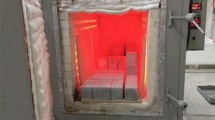Abstract
Results are given for the fracture energy of concrete preheated to temperatures in the range of 20°C–600°C, then tested at room temperature in three-point bending, for both slowly-cooled specimens and those delivered a thermal shock. Fracture energy measurement techniques are discussed, and comparisons made across previous studies. The results suggest a significant difference between residual and ‘hot’ capacities, along with a temperature dependence on the ductile-brittle transition.
Résumé
On présente des résultats concemant l'énergie de fracture de bétons préchauffés de 20 à 600°C, puis essayés à température ambiante en flexion 3 points, à la fois sur des éprouvettes refroidies lentement et sur des éprouvettes ayant subi un choc thermique. On discute les techniques de mesure de l'énergie de fracture et on compare les résultats avec ceux obtenus dans des études antérieures. Les résultats laissent entrevoir une différence importance entre les capacités résiduelles et les capacités «à chaud», ainsi qu'une dépendance de la transition ductile-fragile par rapport à la température.
Similar content being viewed by others
References
Mohamedbhai, G.T., ‘Effect of exposure time and rates of heating and cooling on residual strength of heated concrete’,Mag. Conc. Res. 38 (136) (1986) 151–158.
Olsen, N.H., ‘Heat-induced explosion in high strength concrete. Report No. 231 Series R. Technical University of Denmark. 1990.
Khennane, A. and Baker, G., ‘Thermo-plasticity model for concrete under transient temperature and biaxial stress’,Proc. Royal Soc. Lond. A 439 (1992) 59–80.
Palmer, G. and Baker, G., ‘A load-cycling technique for R-curve behaviour: Application to a low cement refractory’,Int. Jnl. Fract. 62 (1993) 233–242.
Thelandersson, S., ‘Effect of high temperature on the tensile strength of concrete’,Nordisk Betong (1972).
Bazant, Z. and Prat, P., ‘Effect of temperature and humidity on fracture energy of concrete’,ACI Materials Journal (1988) 262–271.
Anderberg, Y. and Thelandersson, S., ‘Stress and deformation characteristics of concrete at high temperatures: 2. Experimental investigation and material behaviour model’,Bull 54, Lund Unviersity of Technology, Lund Sweden (1976).
Ehm, C. and Schneider, U., ‘The high temperature behaviour of concrete under biaxial conditions’,Cem. & Conc. Res. 15 (1985) 27–34.
Van Mier, J.G.M. and Nooru-Mohamed, M.B., ‘Fracture of Concrete under tensile and shear-like loading’, Fracute Toughness and Fracture Energy-Test Method for Concrete and Rock, eds. Mihashi, Takahashi, & Wittmann. Rotterdam: A.A. Balkema (1989) 549–563.
RILEM TC 50-FMC, ‘Determination of the fracture energy of mortar and concrete by means of three-point bend tests on notched beams’,Mater. Struct. 18 (1985) 285–290.
Hillerborg, A., ‘Existing methods to determine and evaluate fracture toughness of aggregative materials—RILEM recommendation on concrete’, Fracture Toughness and Fracture Energy-Test Methods for Concrete and Rock, eds. Mihashi, Takahashi, & Wittmann, Rotterdam: A.A. Ballkema (1989) 145–151.
Wittmann, F.H., Mihashi, H. and Nomura, N., ‘Size effect on fracture energy of concrete’,Engrg. Frac. Mechs. 35 (1–3) (1990) 107–115.
Brameshuber, W. and Hilsdorf, H.K., ‘Influence of ligament length and stress state on fracture energy of concrete’,Engrg. Frac. Mechs. 35 (1–3 (1990) 95–106.
Rice, J., Paris, P., Merkle, J., ‘Progress in flaw growth and fracture testing’,ASTM STP 536 (1973) 231.
Karihaloo, B. L. and Nallathambi, P., ‘An improved effective crack model for the determination of fracture toughness of concrete’,Cem. & Conc. Res. 19 (1989) 603–610.
Schneider, U., ‘Concrete at high temperatures—a general review’,Fire Safety Jnl. 13 (1988) 55–68.
Dias, W.P.S., Khoury, G.A. and Sullivan, P.J.E., ‘Mechanical properties of hardened cement paste exposed to temperatures up to 700 C (1292 F)’,ACI Mater. Jnl. 87 (2) (1990) 160–166.
Author information
Authors and Affiliations
Rights and permissions
About this article
Cite this article
Baker, G. The effect of exposure to elevated temperatures on the fracture energy of plain concrete. Mat. Struct. 29, 383–388 (1996). https://doi.org/10.1007/BF02486347
Issue Date:
DOI: https://doi.org/10.1007/BF02486347




